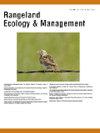夏末集约放牧:洪水泛滥的潘帕草原除草剂的替代方案
IF 2.4
3区 环境科学与生态学
Q2 ECOLOGY
引用次数: 0
摘要
泛滥的潘帕草原拥有高保护价值的草原,并为高地的广泛畜牧业生产提供了放牧场所,而低地的生产力较低。冷季C3草的地上净初级生产力(ANPP)限制了该地区的畜牧业生产。因此,与全年连续放养的不促进(NP)传统管理相比,实施了两种管理方法来促进这些旱草的ANPP:除草剂促进(HP)和不太常见的夏末集约放牧(LSIG)。在这里,我们比较了LSIG作为除草剂的潜在替代品在促进冷季草产量方面的有效性,并评估了短期和长期对年际和次年际ANPP的影响。为此,我们将2013 - 2019年的ANPP遥感数据与气象站的降雨数据、野外观测数据和农场管理者提供的管理信息进行了整合。我们发现,与高原的NP相比,HP和LSIG在较冷的月份都成功地促进了ANPP (P <;0.05)。然而,在高压下,这是以牺牲暖季牧草和年ANPP为代价的,以至于在高压下,旱地的年ANPP降低到与通常较低生产力的低地相似的值。我们的研究表明,使用或不使用除草剂都可以成功地促进冷季牧草的生长,但HP会导致牧草资源的长期退化。与HP相反,LSIG是一种管理方式,它协调了洪水泛滥的潘帕草原的牲畜生产和草原保护的双重目标。本文章由计算机程序翻译,如有差异,请以英文原文为准。
Late Summer Intensive Grazing, an Alternative to Herbicide Application in Rangelands of the Flooding Pampa
The Flooding Pampa harbors grasslands of high conservation value and provides grazing ground for extensive livestock production in uplands while lowlands are less productive. The Aboveground Net Primary Productivity (ANPP) of cool-season C3 grasses limits livestock production in this region. Consequently, two managements have been implemented to promote ANPP of these upland grasses, in contrast to the No Promotion (NP) traditional management with continuous stocking during the entire year: Herbicide Promotion (HP), and less commonly, Late Summer Intensive Grazing (LSIG). Here, we compare the effectiveness of LSIG as a potential alternative to herbicide application in promoting cool-season grass production and evaluate both short- and longer-term impacts on inter- and sub-annual ANPP. To this end, we integrated remotely sensed ANPP data from 2013 to 2019 with rainfall data from meteorological stations, field observations, and management information provided by farm managers. We found that in comparison to NP in uplands, both HP and LSIG successfully promoted ANPP during the cooler months (P < 0.05). However, under HP, this came at the expense of warm-season grasses and annual ANPP, to such an extent that upland annual ANPP under HP was reduced to similar values of the normally less productive lowlands. Our study showed that cool-season grasses can be successfully promoted with or without herbicide use, but HP leads to a longer-term degradation of forage resources. Contrary to HP, LSIG is a management that reconciles the dual goals of livestock production and grassland conservation in the Flooding Pampa.
求助全文
通过发布文献求助,成功后即可免费获取论文全文。
去求助
来源期刊

Rangeland Ecology & Management
农林科学-环境科学
CiteScore
4.60
自引率
13.00%
发文量
87
审稿时长
12-24 weeks
期刊介绍:
Rangeland Ecology & Management publishes all topics-including ecology, management, socioeconomic and policy-pertaining to global rangelands. The journal''s mission is to inform academics, ecosystem managers and policy makers of science-based information to promote sound rangeland stewardship. Author submissions are published in five manuscript categories: original research papers, high-profile forum topics, concept syntheses, as well as research and technical notes.
Rangelands represent approximately 50% of the Earth''s land area and provision multiple ecosystem services for large human populations. This expansive and diverse land area functions as coupled human-ecological systems. Knowledge of both social and biophysical system components and their interactions represent the foundation for informed rangeland stewardship. Rangeland Ecology & Management uniquely integrates information from multiple system components to address current and pending challenges confronting global rangelands.
 求助内容:
求助内容: 应助结果提醒方式:
应助结果提醒方式:


